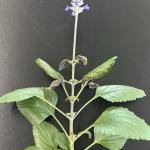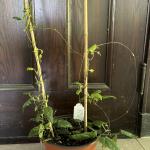This week salvia and thunbergia plants were submitted to the UMass Plant Diagnostic Lab showing distorted growth on younger leaves, with leaf margins curling downward, and rough, bronzed leaf undersides. Some of the younger leaves were brown and dying. Close observation revealed that the plants were infested with broad mites.
Broad mites (Polyphagotarsonemus latus) can be a serious pest of a wide range of greenhouse ornamental plants including begonia, New Guinea impatiens, dahlia, fuchsia, gerbera daisy, English ivy, lysimachia, salvia, snapdragon, verbena, vegetative petunia, peppers, thunbergia, torenia, African violet, cyclamen, and gloxinia. Broad mites are extremely small and nearly impossible to see with the naked eye. Adults are approximately 0.25mm (0.0009 inch) long, shiny, amber to dark green and oval-shaped. Eggs are oval, white, and covered with bumps.
It is possible to see the mites using a high magnification lens (20-30X) with good lighting. When scouting, examine the plants in the immediate area of plants with damage. Broad mite populations are often higher on plants next to plants showing symptoms. The diagnostic lab can also provide quick help to determine if you are dealing broad mites.
Broad mites have piercing mouthparts and feed on the undersides of young leaves and flower buds. This causes leaf margins to curl downwards and prevents flowers from fully developing. They inject a phytotoxin as they feed which causes twisted, hardened, and distorted growth on the plant terminals, and leaf undersides to become rough and take on a bronze color. Severely infested plants become stunted, and may eventually die.
Broad mites can be dispersed within a greenhouse by workers or equipment, or by movement of infested plant material. The best way to detect infestation is to inspect your crops regularly for broad mite feeding damage. Rogue out infested plants as soon as possible. If detected early, it may be feasible to discard a small number of infested plants. Keep growing areas weed free and cleaned thoroughly between crops. Avoid working in an area with broad mites and then moving to a clean crop. Before pursuing treatment for broad mites make sure you have accurate diagnosis. If characteristic symptoms are seen, send samples to a diagnostic laboratory where they can be inspected under a microscope.
Weekly releases of predatory mites Neoseiulus cucumeris and Amblyseius swirskii are used successfully to suppress broad mites on greenhouse crops. It is important to apply the predatory mites early in the crop production cycle before broad mites become established. Broad mites are also easily controlled using selective miticides. Not all miticides labeled for spider mites are labeled for broad mites. Translaminar miticides such as AvidTM (or generic Abamectin), SavateTM (Spiromesifen) and PylonTM (Chlorfenapyr) are more effective than contact miticides. Be sure to follow label precautions for crop safety. For example, the SavateTM label recommends not spraying impatiens species including New Guinea impatiens.
For more information on miticides labeled for control of broad mites on greenhouse crops see the latest edition of the New York and New England Management Guidelines for Greenhouse Floriculture and Herbaceous Ornamentals.
- Geoffrey Njue, Extension Specialist, UMass Extension Greenhouse Crops and Floriculture Program. Photos by Dr. Angela Madeiras, UMass Extension Plant Diagnostic Lab



